If you need to create an effective webinar promotion strategy for upcoming webinars, this ultimate guide will walk you through everything you'll need to know including:
NOTE: While our webinar platform, eWebinar, only supports pre-recorded webinars, the webinar promotion advice in this ultimate guide can be applied to both live and automated webinars.
Let's dive in!
Webinar promotion best practices
If you want to skip straight to the top nine webinar promotion strategies, click here!
Before we go into the list of ideas for webinar promotions there are three foundational best practices to follow to make sure you get the highest ROI on your promotion efforts:
-
Audience research
-
Landing pages
-
Scheduling
1. Know your audience
Your target audience will influence the webinar topic you cover, which promotion channel(s) you leverage, and what the messaging on your landing page will be. When in doubt, interview your sales, support, and/or customer success representatives to identify specific buyer personas.
Note: Your sales team will often provide the best information about fresh leads or new customers while your support and success representatives can give you insight into existing customers.
Once you've identified your target audience, create a list of broad-but-actionable topics that have wide enough appeal to bring in webinar registrants during the promotion phase. You'll want to compile a list of multiple candidate topics and then rank them in order of potential.
2. Build a high-converting landing page
First and foremost, you need to ensure that the webinar landing page you're driving people toward with your promotion efforts is converting well enough to turn visitors into registrants otherwise all your promotion efforts will be wasted.
Before you start optimizing anything else, you need to start by perfecting your above-the-fold copy — which consists of your headline and anything else that's visible on the page without having to scroll down.
In general, a good webinar title communicates the topic being covered while teasing the benefits and creating a sense of urgency. If you were invited to two webinars on the same day but only had time for one, which title would sound more appealing to you:
-
Get More Traffic With Content Marketing (Webinar)
-
How to 2x Organic Traffic With On-Page SEO [Registration Ends Soon]
The second title is more compelling because both the strategy (on-page SEO) and outcome (doubling organic traffic) are specific in contrast to the vague benefits like "more traffic" or umbrella terms like "content marketing" used in the first example.
It also uses a registration deadline to prompt a sense of urgency and get people to register sooner. Another approach would be to use [Limited Spots Only] since scarcity can be just as effective as urgency in compelling strangers to sign up for your webinar.
Beyond the title, other elements you may want to include above the fold include:
-
Registration form/button
-
Time/date of the event
-
Countdown timer
Once you've hooked visitors in and gotten them to scroll down, you can begin writing the finer details.
At its core, there are four questions that webinar landing pages need to answer to get people to sign up:
-
Is this for me?
-
Who’s behind this training?
-
Can I trust what they’re teaching?
-
When can I watch?
Ideally, the title would be clear and compelling enough to take care of the first question. However, adding an agenda in the form of a short bullet list would be a good way to give interested parties a more detailed look at what will be covered during the webinar.
Answering the second question all comes down to how well you can establish the credibility of the host and/or guest speakers who'll be delivering the presentation. Inserting an author bio with the name, role, company, and headshot of each presenter can help with that.
Tip: To further increase credibility, consider mentioning how many years of industry experience each presenter has, listing any awards they've won, and including suffixes like CPA, MD, PhD, or Esq.
Slack uses both bullet agendas and author bios to great effect in their webinar landing pages:

Source: Slack
To see more like this, read our full list of 28 Webinar Landing Page Examples!
3. Schedule your webinar on the best time and day
Even if you promote upcoming webinars, it won't do you much good if the schedule is inconvenient.
Have you ever wondered what the best time and day to host a webinar is? Well, according to the data from an analysis of 250,000 webinars, Wednesday and Thursday are the best days of the week to host a webinar.
In fact, the statistics showed that the three days in the middle of the week account for 77% of all webinars and get the highest attendance rates — which makes sense since people are usually busiest at the start or end of their workweek.
As for the optimal time, ON24's research found that 11 AM and 2 PM (in the attendee's local time zone) are the best time slots because they allow people to attend during less-busy midday hours without interrupting their lunch break.
While hosting webinars on Wednesday and Thursday at 11 AM or 2 PM does make for the "statistically ideal" schedule, their edge over other times/days isn't that drastic. What has a far more significant impact on webinar attendance is how many people can conveniently attend your presentation.
Making your webinars available on-demand (or automating them to run on a recurring schedule) will increase attendance through convenient accessibility — much in the same way that people would rather binge Netflix than watch live broadcasts.
Customers who host on-demand webinars on our webinar platform, eWebinar, average a 65% attendance rate — with many getting attendance rates as high as 80% to 100%:
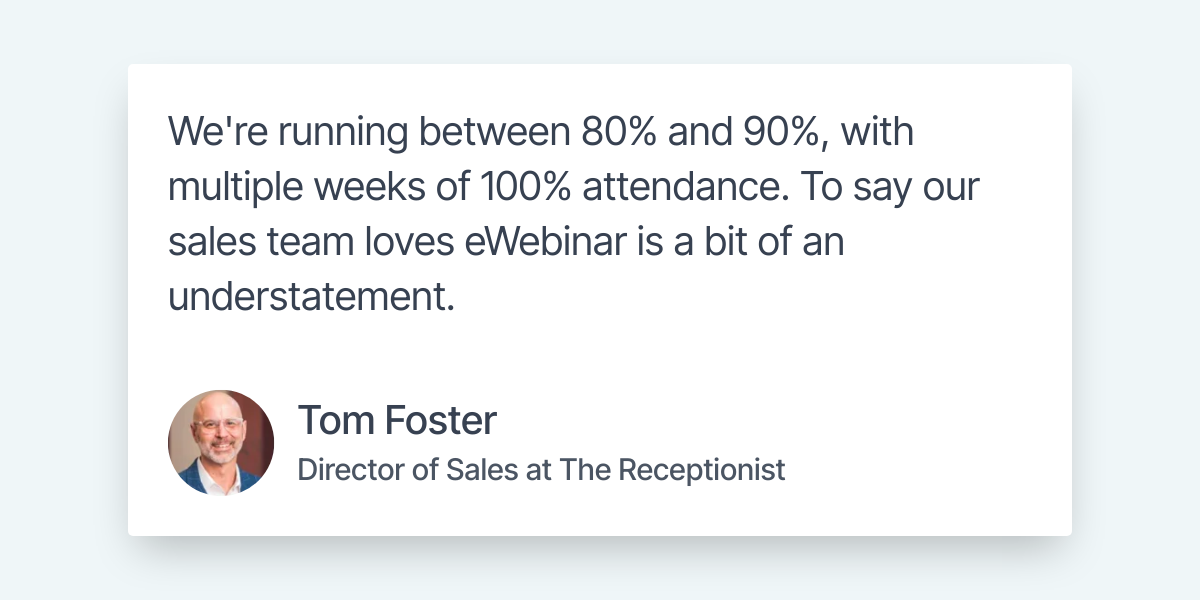
Read The Receptionist case study →
In contrast, the average attendance rate for live webinars is only around 40%.
To experience an on-demand webinar for yourself, watch our demo!


Top 9 webinar promotion strategies
By pinpointing your target audience, creating a landing page that's optimized to convert traffic into registrants, and choosing a schedule that maximizes reach, you've laid the groundwork for your webinar promotion efforts to deliver an ROI.
The nine best ways to promote your webinar are:
The sections below will give you a closer look at each of these proven webinar promotion strategies!
1. Social media
Social media platforms have become the go-to channel for promoting webinars because they allow you to reach a large audience in a short amount of time at a relatively low cost. The two most popular social media platforms for webinar promotion are undeniably Facebook and LinkedIn.
Facebook is the largest social network in the world with three billion monthly active users (MAUs) — which equates to over a third of the global population. If raw reach is your goal then Facebook has the biggest addressable user base out of any platform.
There are three avenues you can take when promoting webinars on Facebook:
-
Facebook pages. Growing a following on your company page can take time and/or money on Facebook but ultimately provides a reliable channel to reach your audience through. We'd recommend promoting your webinar through the cover image on your Facebook page.
-
Facebook events. Because normal posts don't have a very long lifespan, creating a Facebook event will provide better visibility for those visiting your page. Your event can even get organic reach from people who don't visit your page directly or be promoted further using paid event ads.
-
Facebook groups. While pages, posts, and events make up the traditional promotion that people think of when hearing about social media, Facebook groups are just as powerful. Building an active community around your brand will help you promote each upcoming webinar with ease.
In addition, Facebook also lets you cross-share content on Instagram since both platforms are owned by the same company. This helps you reach audiences on two platforms at once with the same amount of effort while reusing existing creative assets.
Note: Avoid spending money on Facebook ads unless your upcoming event will generate revenue or, in the case of on-demand webinars, is already generating revenue
For SaaS companies targeting B2B audiences, LinkedIn is the far superior platform compared to Facebook or any other social network. While it doesn't have as many users as Facebook, LinkedIn has been steadily growing over the past few years — eventually hitting one billion users by the end of 2023:
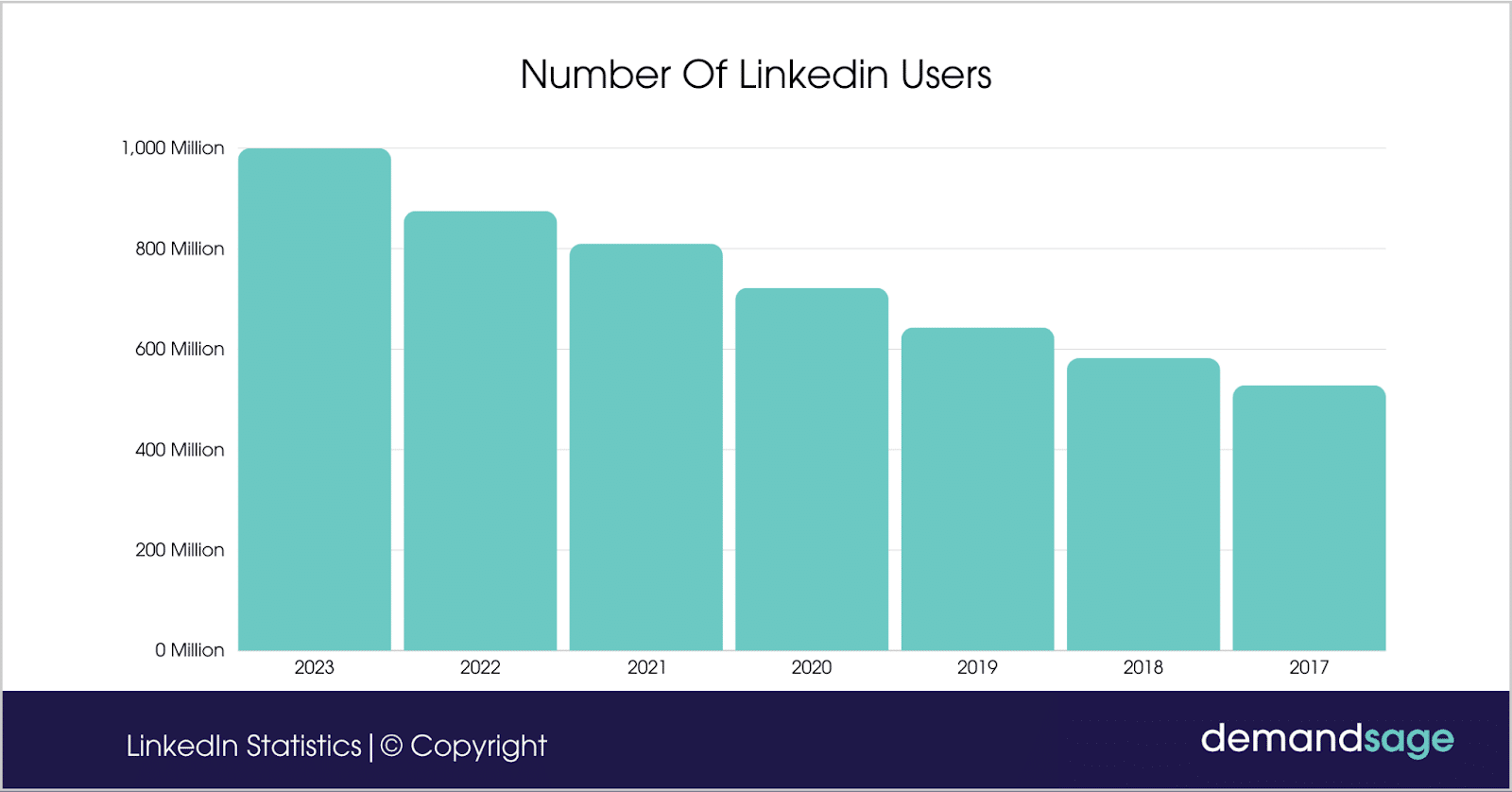
Source: DemandSage
Unfortunately, LinkedIn doesn't specify how many of these are monthly active users. Regardless, the same best practices apply when promoting on LinkedIn such as placing webinar details in the cover image of your company page and creating an event to increase reach within the platform.
What differentiates LinkedIn from Facebook — other than its business-centric demographics — is the emphasis on organic posts and connection requests. Regularly creating content and growing your network can help you compound momentum until some of your posts get enough reach to go viral.
Here are a few examples of social media posts from Melissa Kwan, the CEO of eWebinar:
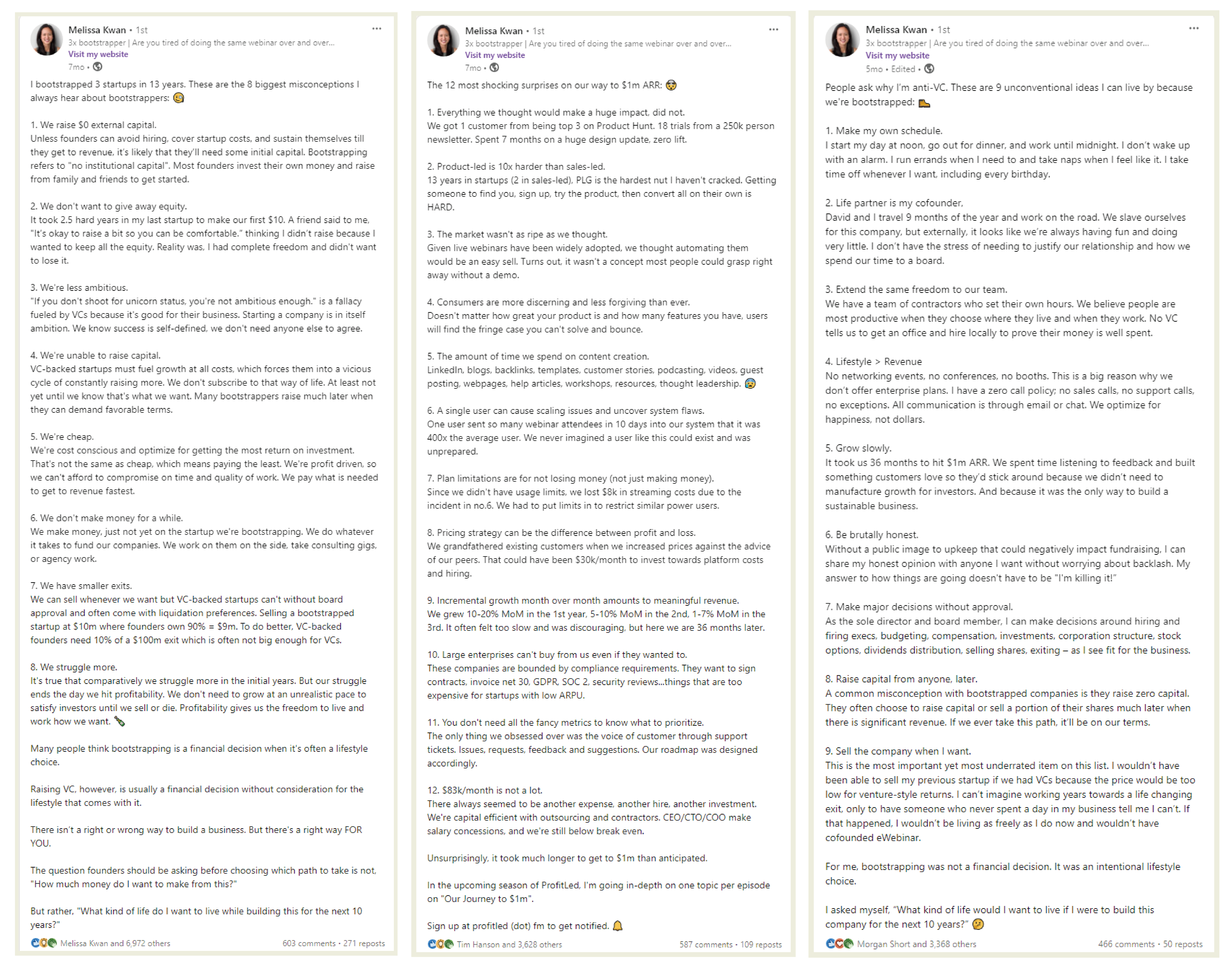
These posts each got:
-
Hundreds of thousands of impressions
-
Thousands of likes
-
Hundreds of comments
One of them even went viral so fast that it broke LinkedIn's impression counter and got stuck at 665,813 (with the actual number being around a million impressions):
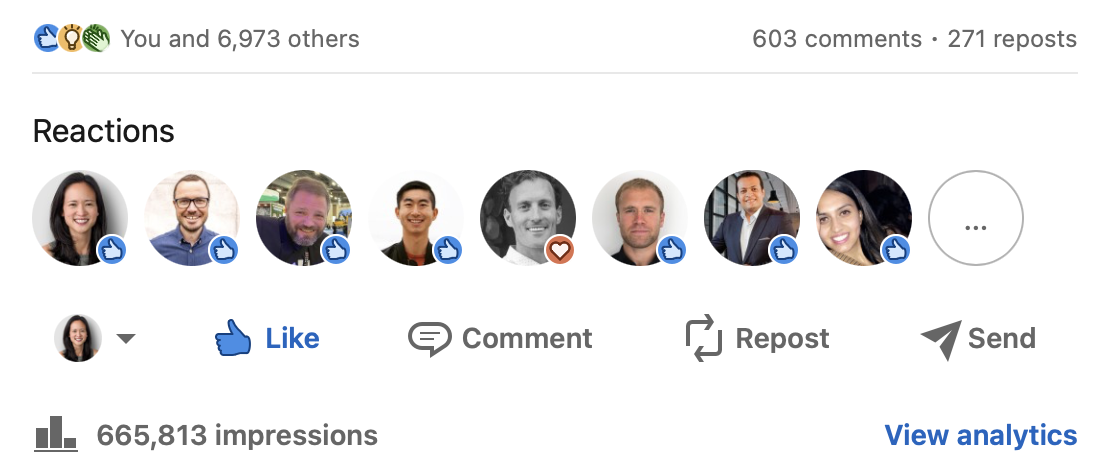
Of course, the reason most creators favor organic reach is due to how expensive LinkedIn ads are:
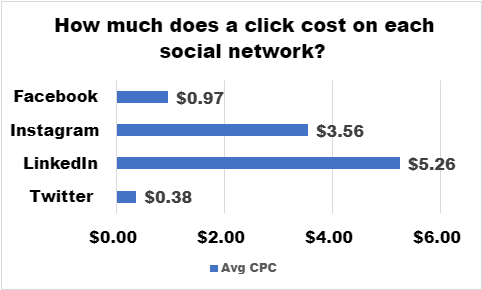
Source: Brandwatch
On average, paid social advertising is over 5x more expensive on LinkedIn compared to Facebook with a cost per click (CPC) above $5. LinkedIn ads aren't overpriced, their CPC just reflects the presence of higher-quality leads who are more likely to convert.
LinkedIn ads also have special features like registration forms that are pre-filled with the user's contact information. This lets interested parties register for the webinar through your ad in just a couple of clicks without having to fill in their information manually.
2. Cross-promotion
If your webinar won't include any guest speakers, co-hosts, or presenters other than yourself then you can safely skip this section. Otherwise, cross-promotion is worth looking into so you can leverage the existing audience(s) of those who'll be a part of your webinar.
That said, you'll need to coordinate in advance since cross-promotion can be a time-consuming endeavor to organize and execute. In a similar vein, you could invite influencers to your webinar or, at the very least, partner with them to reach larger audiences.
3. In-app popups
If you're running SaaS webinars, you could use in-app notifications to promote your webinar from within the product itself. You could even use browser notifications and push notifications (if your SaaS product has a mobile app) to further increase the reach of your webinar promotion campaign.
The best part is that you don't need to hardcode these webinar popups into your product to display them to users. Onboarding platforms and product adoption software often let you embed modal popups on top of your native user interface without writing a single line of code.
4. Email marketing
Sending webinar invitations out to existing audiences — such as newsletter subscribers — can be a quick way to get an influx of registrants. In addition to one-off invites, you could even include a list of upcoming virtual events or ongoing webinar series in your weekly/monthly newsletters.
This is especially easy if your webinar platform has native integrations with email marketing software. eWebinar integrates with email marketing platforms like ActiveCampaign, ConvertKit, MailerLite, and Mailchimp — not to mention other third-party applications like HubSpot, Salesforce, and Zapier:
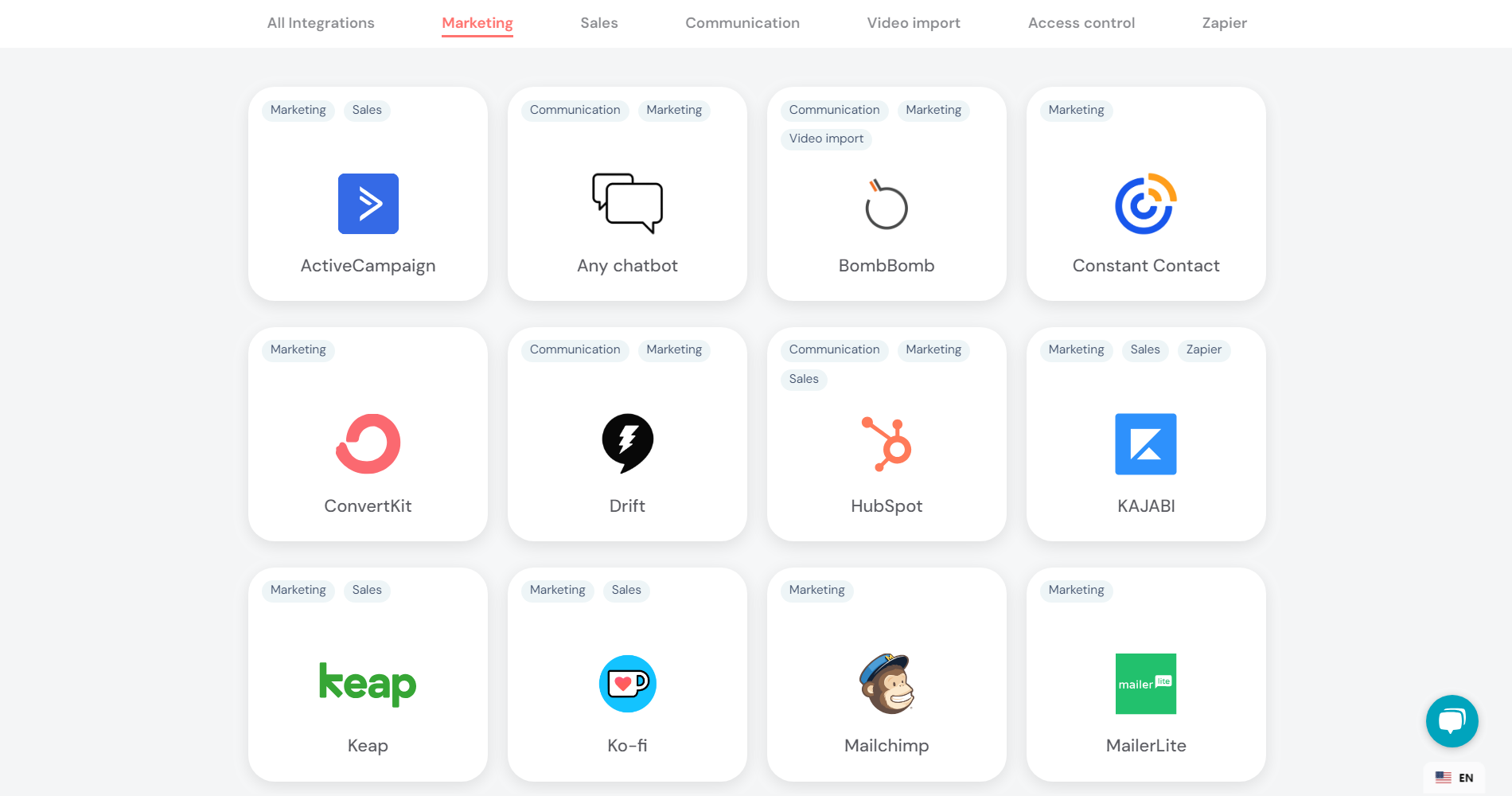
Tip: You can also send out retargeting sequences to invite those who have previously attended one of your webinars.
5. Press releases
In a similar vein to email marketing, you can promote webinars through press releases to extend your reach — if you're willing to bear the cost. PR Newswire, the most popular press release distributor, can send releases to its network of 4,500 websites across the US or 10,000 websites around the world.
However, you'll need to pay hundreds to thousands of dollars to publish your press release.
Specifically, a $350 to $800 base fee not including the cost of an annual membership and the additional charges when including logos, images, or additional text beyond the 400-word limit. This means you could easily end up paying upwards of $2,000 per press release depending on its length and content.
Distribution can be even more expensive than the press release itself!
While distribution pricing may start at $1,200 for press releases targeting the US and Canada, the cost quickly shoots up to $8,700 for those seeking global reach. Furthermore, massive reach doesn't always result in registrants or attendees due to the low purchase intent of those reading the press release.
Note: Press releases may still be a worthwhile option when hosting webinars within the finance industry since getting published on Yahoo! Finance or MarketWatch could boost your registration and attendance.
6. Paid advertising
Speaking of expensive promotion strategies, paid media/advertising is another capital-intensive promotion channel. The difference between paid ads and other types of paid promotions is that the former offers more granular control over how much you'll be spending.
Whereas press releases often have base fees starting in the hundreds of dollars, you can start running paid ads with five bucks. Of course, you probably won't get much traction with that low of a budget but at least the barrier to entry is much lower than other paid promotion avenues.
A word of caution is that you should only start spending money on paid ads once you're reasonably certain that the landing page and webinar itself are converting well. It also makes more sense to spend on ads for pre-recorded webinars since those are evergreen sales assets rather than one-time events.
Note: Paid advertising will only be able to generate leads for as long as you're able to pump money into it. Over time, your ads will fatigue and require fresh creative assets or a higher budget to maintain results.
7. Organic content
Similarly to paid ads, advertising upcoming webinars through organic content makes more sense for pre-recorded webinars that you'll be using as an evergreen asset — except this time it's due to time constraints rather than financial concerns.
Organic content can take a while to rank (especially for newer websites) and get traction in search results which means that, by the time your live event rolls around, the content you wrote to promote it may not even be getting traffic yet.
A more sensible approach would be to add registration widgets to relevant blog posts that are already getting traffic:
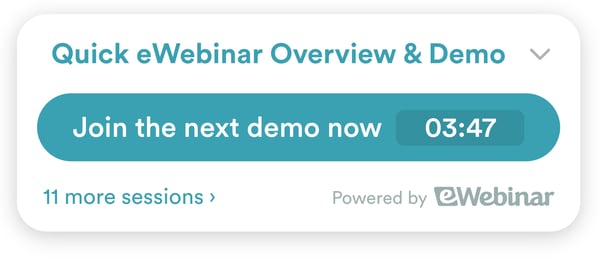
A potential alternative would be to guest post on high-authority sites that have the benefit of existing traffic and faster indexing. However, guest posts can take a while to be approved and published so be sure to schedule webinar promotions ahead of time when taking this approach.
Tip: Know which keywords you plan to target ahead of time to ensure the webinar's topic and title are conducive to being promoted through organic content.
8. Trade shows
Advertising at trade shows only really makes sense for hybrid events that take place both through online webinars and in-person venues. If you try to promote online-only events through trade shows, your efforts will either be drowned out by the noise or forgotten by the time the live webinar takes place.
That said, hybrid events (when executed properly) have shown promise in recent years.
HubSpot's INBOUND conference got 11,000 in-person attendees and over 100,000 livestream views online. This is despite the fact that tickets were far from cheap with general admission starting at $675 and VIP passes going as high as $1,899.
That said, HubSpot had a pre-existing customer base made up of over 194,000 businesses using their CRM platform across more than 120 countries worldwide. If you don't have a global audience of similar scale then your mileage may vary when it comes to running hybrid events.

9. Reminders
The journey doesn't end once you get webinar registrations. If you want to ensure that people follow through and actually show up, you'll need to send regular reminders to the email address they used to register for your webinar in the first place.
Sending reminders a week, day, and two hours before the webinar will keep registrants from forgetting about the event they signed up for. If you let registrants watch your webinars on-demand then you won't need to send reminders since they can attend the presentation at their peak moment of interest.
Ultimately, promoting your webinar to those who have already registered provides the highest ROI because they're the crowd of people who are most interested in the event. Think of this as the last step towards turning registrants into actual webinar attendees.
Webinar promotion timeline
Webinar promotion timing is key as when you promote is almost as important as how you promote.
Here's an eight-week promotion timeline you can use to promote your own webinars:
-
Eight weeks before. Finalize the topic based on your business goals, target audience, and organic keywords.
-
Seven weeks before. Choose a webinar platform based on which features you need and the webinar format (live or automated).
-
Six weeks before. Publish a landing page with an attractive headline, agenda description, and registration form.
-
One week before. Send your first reminder to registrants.
-
One day before. Send your second reminder to registrants.
-
Two hours before. Send your final reminder to registrants.
To learn more, check out our Ultimate Webinar Checklist which comes with a free downloadable checklist!
3 webinar promotion examples
To offer some inspiration for your next webinar, here are three examples of how veteran hosts promoted some of their most successful webinars:
1. The Receptionist
The Receptionist uses on-demand demo webinars — or deminars — with sessions running every half-hour resulting in multiple weeks of 100% attendance rates.
You'll find a high-contrast blue button at the top of their homepage which leads to the pre-recorded product tour:
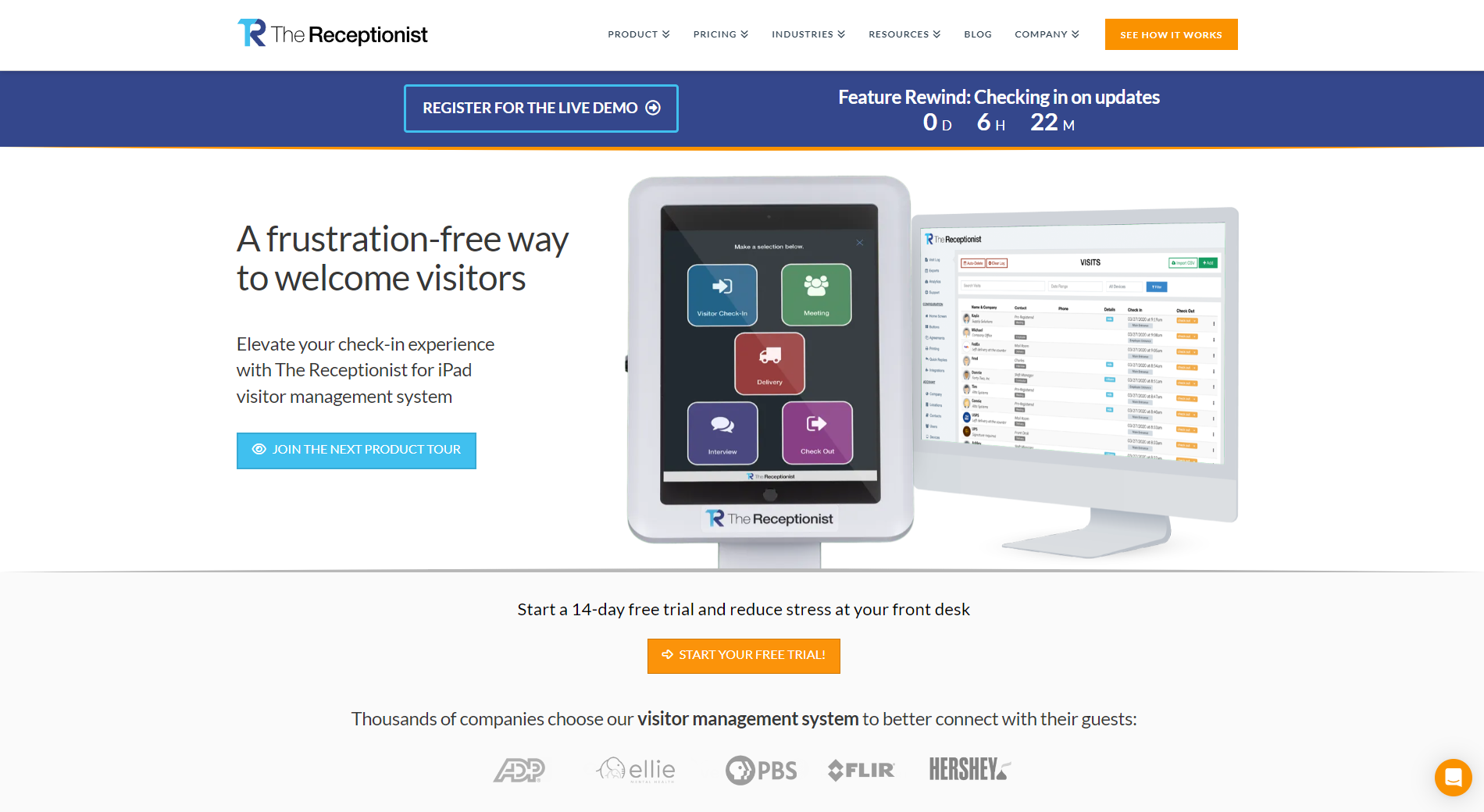
Anyone who clicks the "Join the next product tour" button will be redirected to their webinar landing page where they can choose a schedule that's convenient for them or join a just-in-time session — which is automatically scheduled to start within a few minutes of them landing on the page:
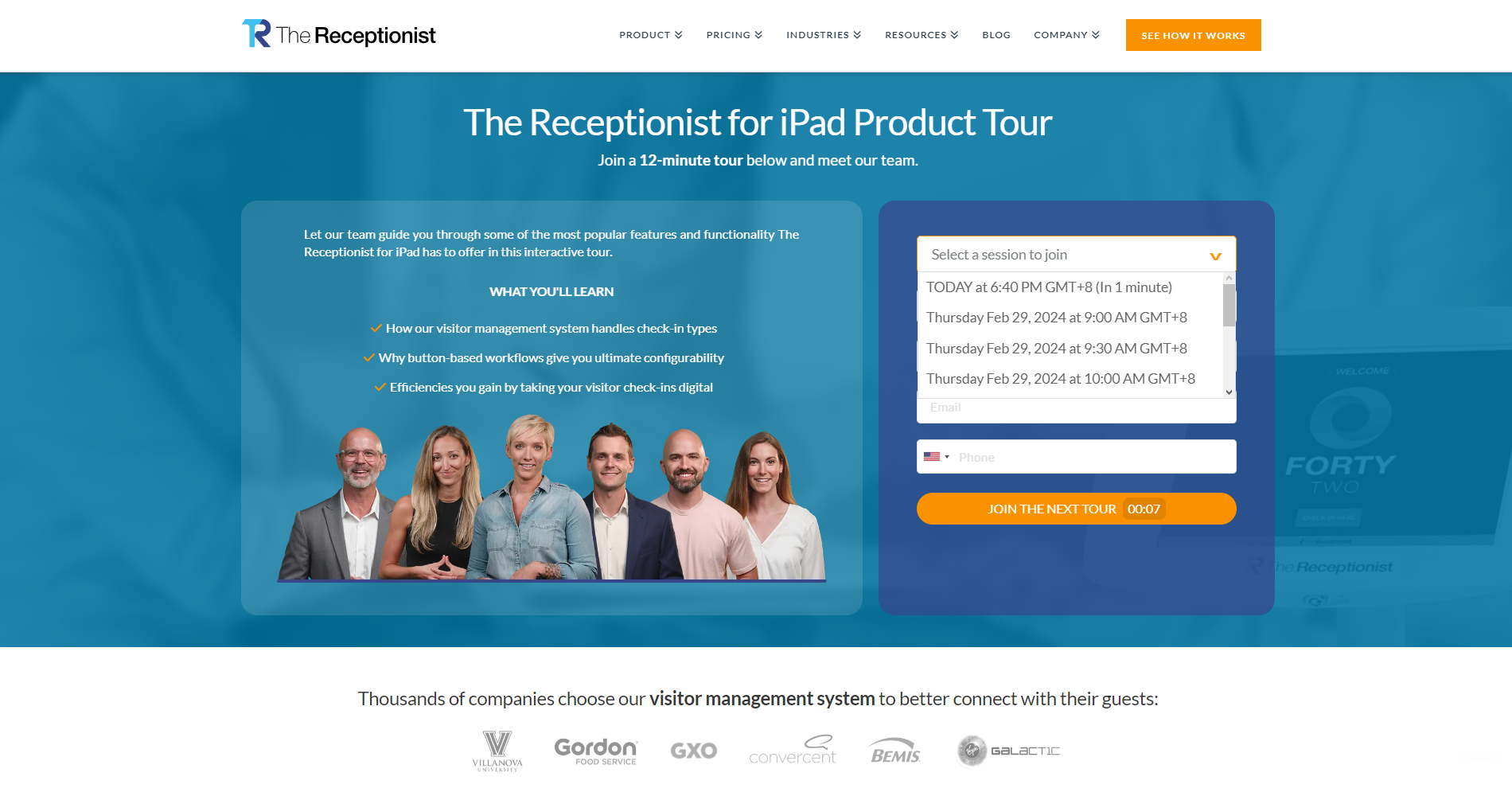
The best part is The Receptionist is regularly getting attendance rates between 80% and 100% on their pre-recorded product demos:

Read The Receptionist case study →
2. Jon Schumacher
Jon Schumacher offers on-demand webinars and automated sessions running on a recurring schedule multiple times per day with an 88% attendance rate — all while tripling his industry's conversion rate.
You'll find the "watch my webinar" button next to Jon's "schedule a call" CTA which allows him to capture leads who aren't ready to jump on a call just yet:
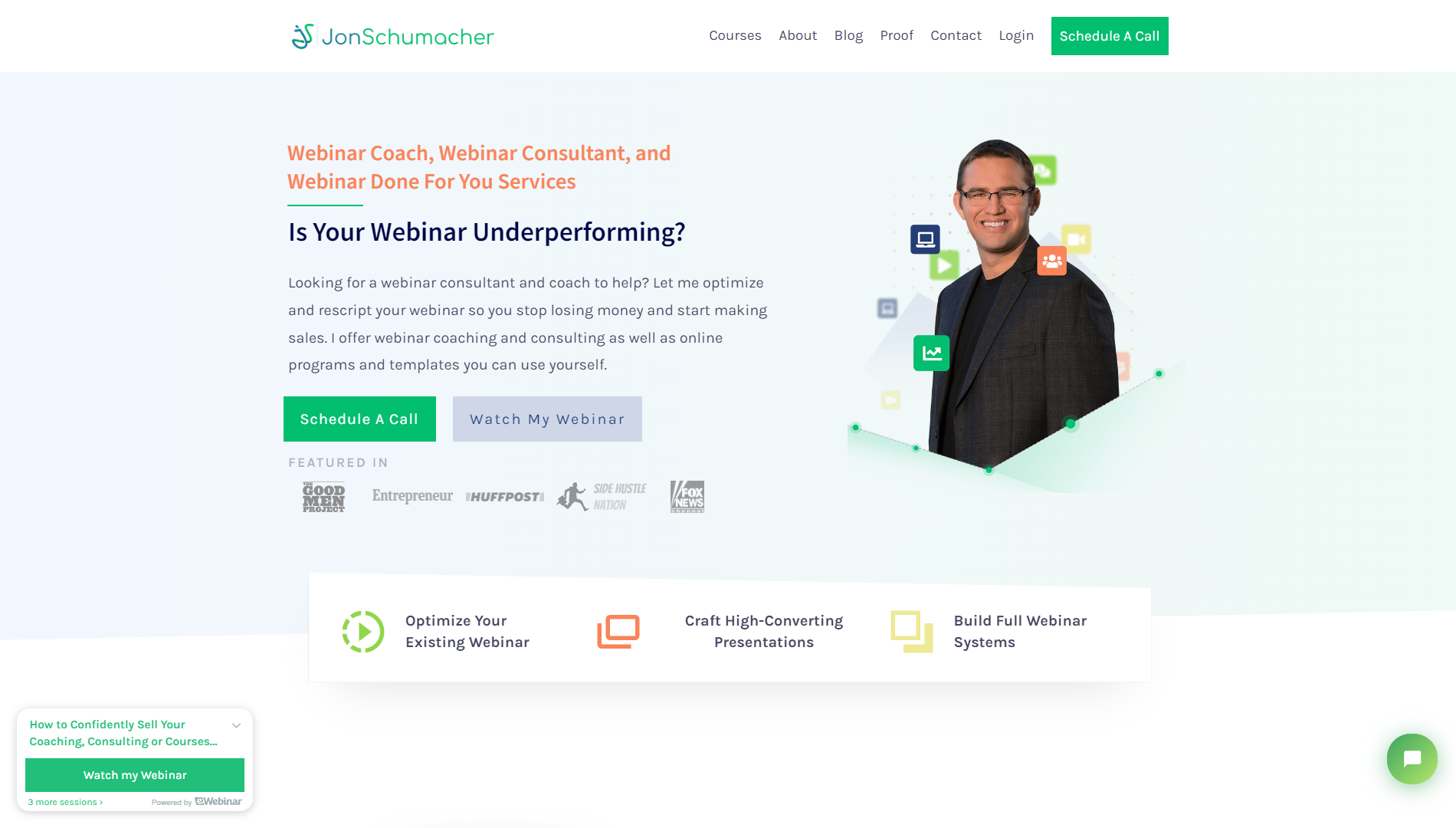
Jon's registration page pitches the on-demand demo as a 30-minute presentation that will teach attendees how to sell with webinars, create webinars faster, and increase sales results:
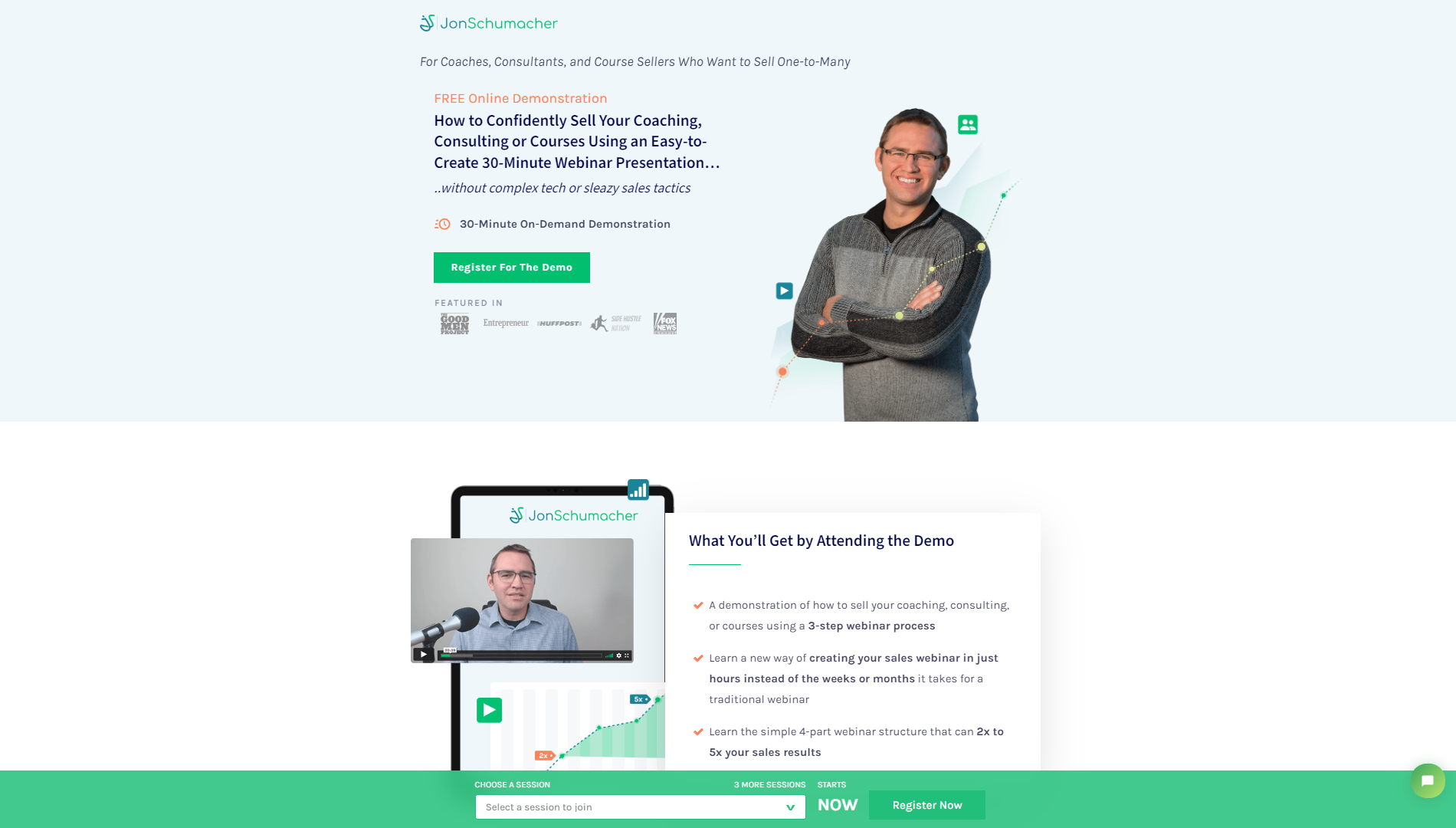
By promoting the webinar above the fold and using a bullet agenda to concisely list the benefits, Jon has managed to achieve excellent attendance and conversion rates:
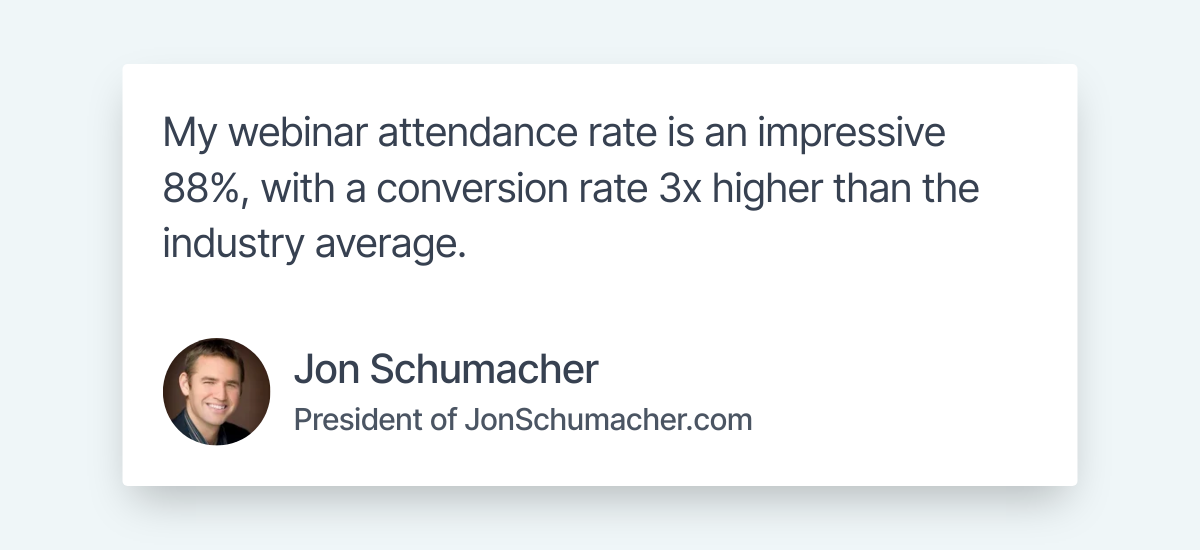
Read Jon Schumacher's case study →
3. MAGFAST
MAGFAST has generated $14 million in sales exclusively through eWebinar without using any other advertising channels:
The yellow demo button stands out against the black background of MAGFAST's homepage while teasing the products featured in the presentation:
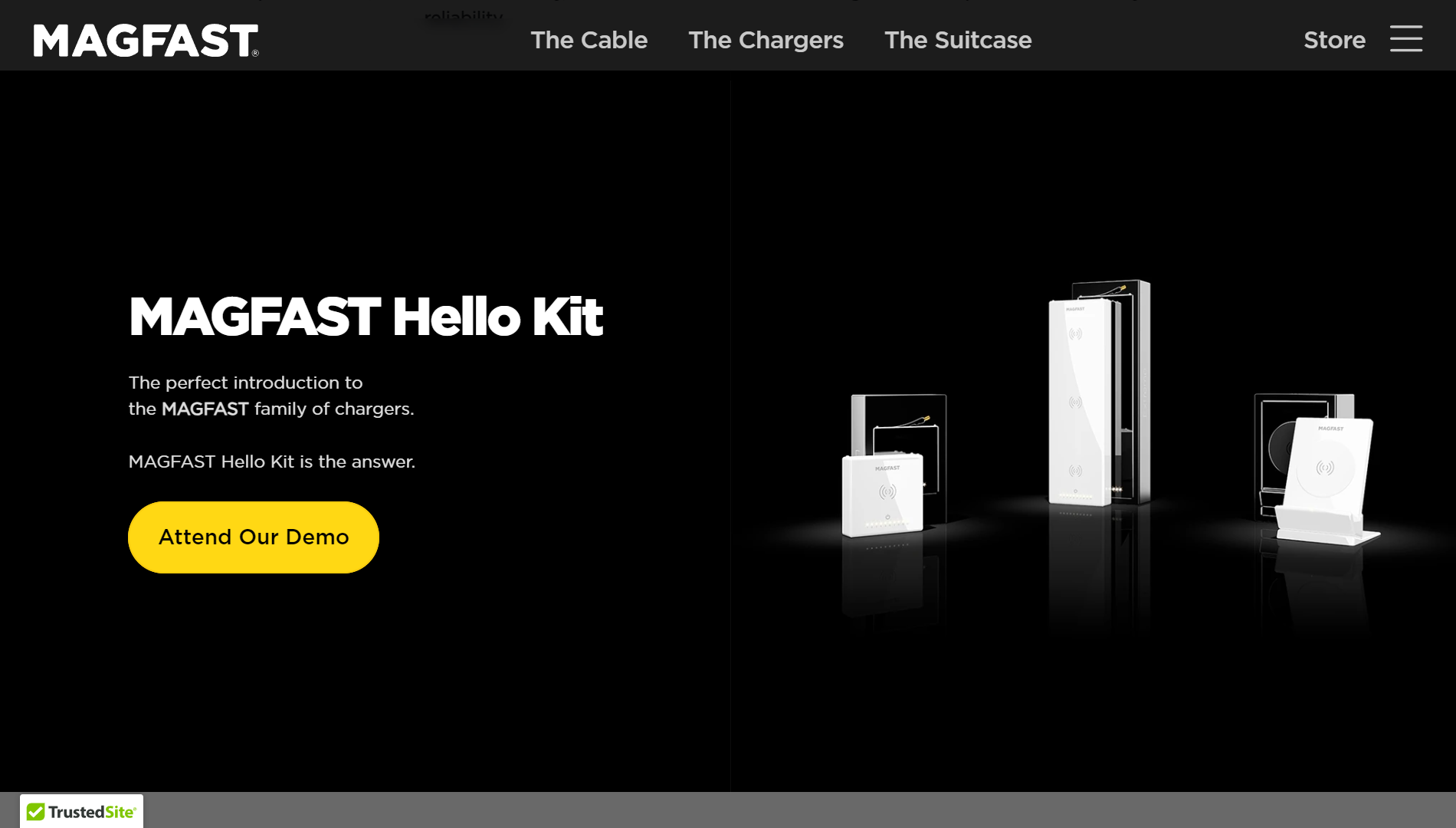
Once you make it to MAGFAST's registration page, you'll be greeted with an autoplaying video that hooks registrants in — along with a giveaway to incentivize reluctant prospects to attend the demo:
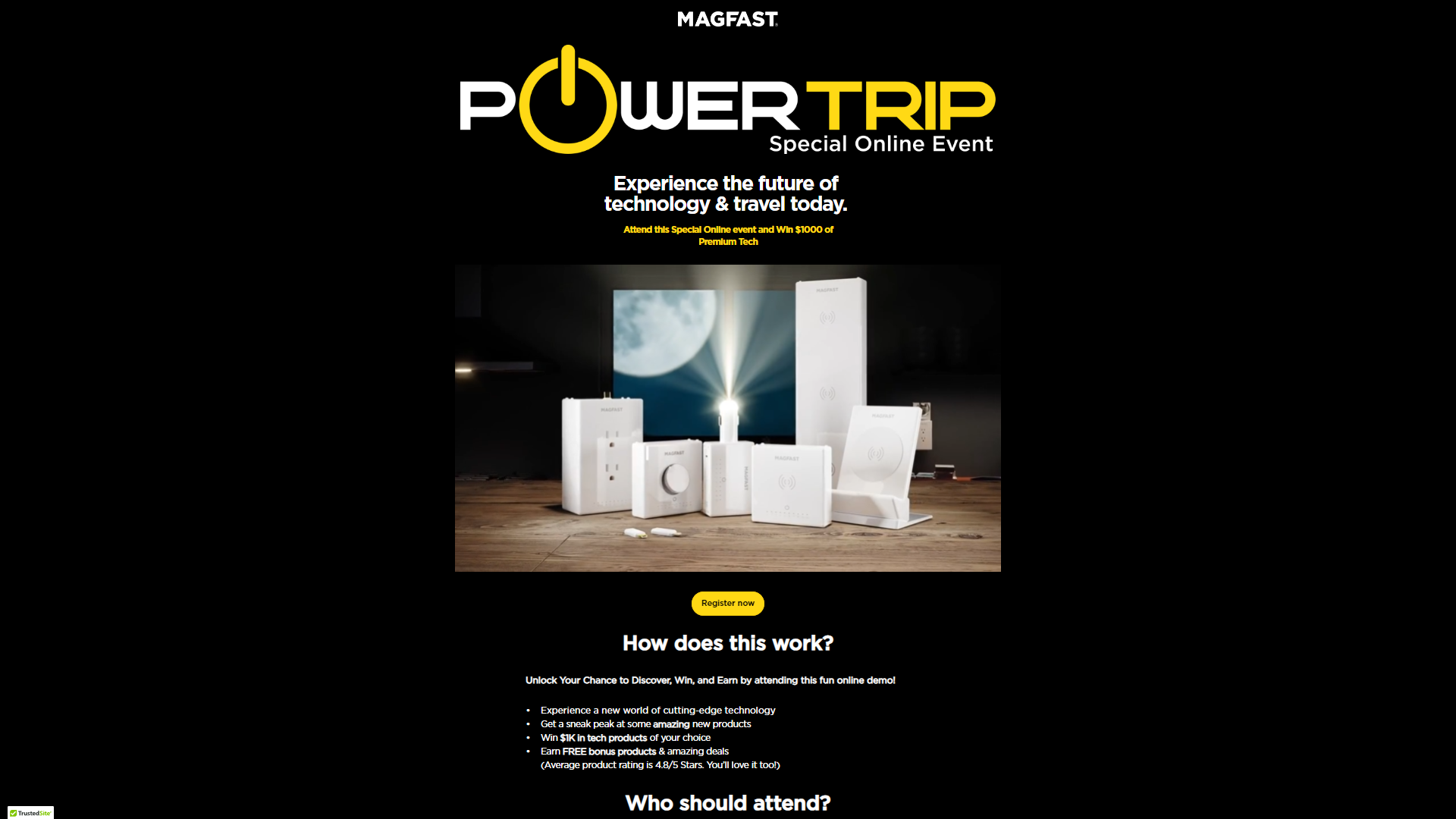
Despite being MAGFAST's sole acquisition channel, automated webinars have managed to generate eight figures in revenue:

If you want to learn more about the webinar platform that The Receptionist, Jon Schumacher, and MAGFAST used then watch our on-demand demo!


Conclusion
As you can see, a lot about running a successful webinar comes down to building an effective webinar promotion plan. If you found the promotion strategies and best practices in this ultimate guide valuable then we'd ask that you watch our demo to see if our webinar platform is the right fit for your needs!








